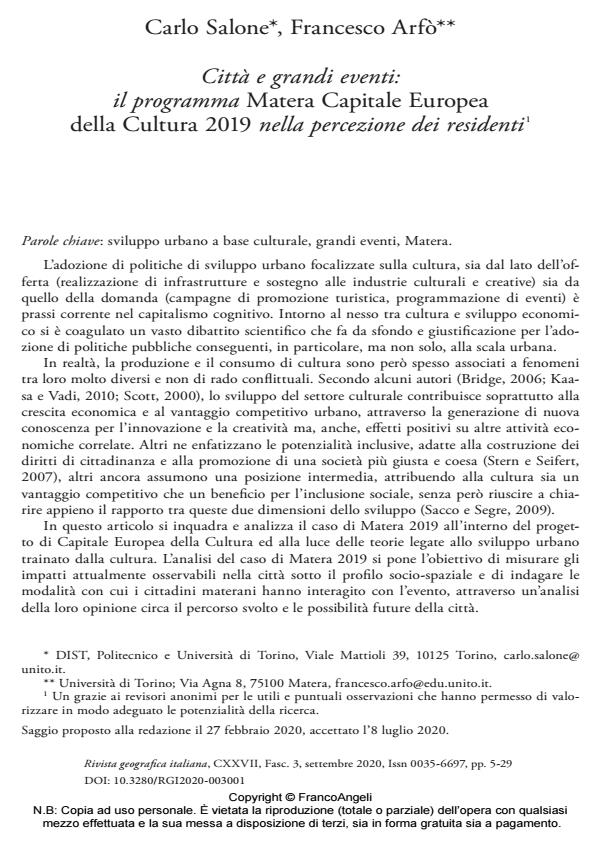Mega-events and the city: Matera 2019 European Capital of Culture in the residents’ perception
Journal title RIVISTA GEOGRAFICA ITALIANA
Author/s Carlo Salone, Francesco Arfò
Publishing Year 2020 Issue 2020/3
Language Italian Pages 25 P. 5-29 File size 250 KB
DOI 10.3280/RGI2020-003001
DOI is like a bar code for intellectual property: to have more infomation
click here
Below, you can see the article first page
If you want to buy this article in PDF format, you can do it, following the instructions to buy download credits

FrancoAngeli is member of Publishers International Linking Association, Inc (PILA), a not-for-profit association which run the CrossRef service enabling links to and from online scholarly content.
In the current accumulation regime, policies of urban development focusing on culture have become a common practice, on both the supply side (offering physical facilities and financial support to the cultural and creative industries) and the demand side (event organisation, tourism promotion campaigns). A broad scientific debate has been developed on the nexus between culture and development, providing a drawback and a legitimation to consistent public policies, especially at the urban scale. However, cultural production and consumption are often associated with very different and often conflictual phenomena. According to some authors (Bridge, 2006; Kaasa e Vadi, 2010; Scott, 2000), the development of the cultural sector supports the economic growth and urban competitive advantage, by generating new knowledge for innovation and creativity but, also, positive effects on the related activities. Others emphasise the ability of culture to include people and enlarge civil rights creating a more equal society (Stern e Seifert, 2007), or assign to culture both competitive advantages and benefits for social inclusion, but do not clarify the relationships between these two dimensions (Sacco e Segre, 2009). In this paper the case of Matera 2019 European Capital of Culture is explored in the light of the culture-driven urban development theories. The analysis of Matera 2019 aims at measuring the socio-spatial impacts currently observable and investigating how the Matera’s residents have interacted with the event, through an analysis of their opinions about the implemented actions and the envisaged scenarios for the city.
Keywords: Culture-led urban development, mega-events, Matera
- Computational Science and Its Applications – ICCSA 2025 Workshops Antonio Magarò, Antonella G. Masanotti, Marina Tonolo, pp.78 (ISBN:978-3-031-97659-9)
Carlo Salone, Francesco Arfò, Città e grandi eventi: il programma Matera Capitale Europea della Cultura 2019 nella percezione dei residenti in "RIVISTA GEOGRAFICA ITALIANA" 3/2020, pp 5-29, DOI: 10.3280/RGI2020-003001